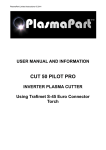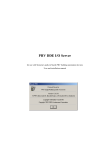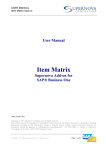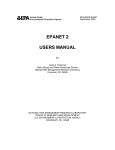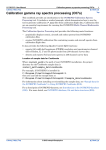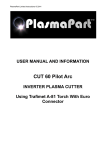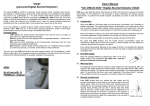Download PRV Use For Leakage Reduction
Transcript
PRV Use For Leakage Reduction: Various Technical Solutions Abstract The use of pressure reduction, as a method for reducing water-loss and labor cost in municipal water supply system, is generally accepted in the industry. However, the real saving in various systems, achieved through the usage of this method, as well as the optimal selection of a control valve and control applicationare rarely known by all. This paper presents some examples for the actual saving in background leakage, Ruptures frequency and demand, in municipal water systems. It will also refer to the theoretical background leading for these results, and explains the characteristics of different control valves, their application and the optimal situations in which they should be utilized. Keywords Pressure management, Dynamic Pressure Reduction, PRV, Flow modulation. Introduction Growing demand, diminishing fresh water sources and increasing treatment costs, gave in recent years a boost to extensive studies and research in the interest of water conservation- and particularly leakage reduction. These studies helped the development of two separate fields: Practices for measuring and assessing the volume and causes for the water losses, and later defining the adequate technique for the reduction of lost water volume. Wide range of products that can be used for the measuring, detecting and reduction of the losses. Many text books and papers discuss the theoretical issues of the leakage causing, and ways to asses and manage the water supply system. But very little attention was given for the actual selection of hydraulic control devices that can deal with such problems. The aim of this document is to guide technicians and engineers, puzzled by a wide selection of technical solutions, in selecting the adequate product for a specific case of hydraulic conditions of their network. Theoretical background A first essential step, for any leakage control scheme, is gaining a fair understanding of the sources for leakage and other real losses in the system. The most common 'Real Losses' sources are: Pipe ruptures Leakage from fittings, joints and small pores in the distributing pipes. [ 1] PRV Use For Leakage Reduction: Various Technical Solutions 2 . Tanks and reservoirs overflow Leakage from Storage tanks Factors that influence the water loss volume and costs: Infrastructure condition – Quality of materials, ground condition, water quality and workmanship. Improving the infrastructure condition usually requires large capital investments. Awareness time (AT) – the average time between the start of the leak until the water-company becomes aware of it. The total volume of water lost from a single leak is the time delay from emergence to fixture multiplied by the average leak flow rate. If a methodology for monitoring the system condition is applied, large rupture would usually be characterized by a very short AT compared with small leaks, that may be left un-noticed for years. Therefore, there is a need for methods and solutions for minimizing the rate of the losses through these small leakage points. Flow Flow Large pipe burst Q Background leakage point (No awareness or too small to justify the cost of fixing) q Awareness Time Reaction time t Time t= Time End of event (fixing) Loss Volume = Q x t Figure 1. Comparing two water-loss types in a network, where the system is monitored and well-maintained. The loss volume through many background leakage points may become much larger than the volume lost due to large pipe breaks. Average Zone Pressure (AZP) has significant influence on both leakage flow rate and creation of new leakage points, and rupture occurrence rate. The ratio between pressure reduction and leakage rate change is calculated by: Q1 = Q0 x (P1/P0)N1 Where N1 factor is 0.5 < N1 < 2.5 and the average value for large systems is N1=1.15 (1) This shows a very strong link, between system pressure and leakage flow rate. A second correlation that should be noted is the one between the system's pressure and the rupture frequency, described by the index N2: B1 = B0 x ( P1 / P0 )N2 System age and conditions influance N2 deviations, but average values for N2 are 2.47 for large mains and 2.36 for distribution lines (2) PRV Use For Leakage Reduction 3 Table 1 shows some sample case studies presenting the very strong link between AZP and rupture frequency 3 Table 1 Percentage reduction in new break numbers, before and after pressure management ( ) A clear conclusion from the above data, is that pressure reduction reduces the leakage flow rate, even at locations where the leak is left undetected or unfixed- as well as reduction in the occurrences of new pipe breaks. 4 PRV Use For Leakage Reduction: Various Technical Solutions . Case study - Gold Coast (Source: Gold Coast City Council web site) A trial on the Gold Coast, involving 12,000 properties in four residential areas, showed significant water saving benefits – • 20% reduction in average daily water consumption • 71% reduction in water main breaks, and • 75% reduction in water service breaks. On the basis of these savings, Gold Coast Water began implementing a full-scale Pressure and Leakage Management Program across the city, which is expected to save up to 10-15ML of water every day – or about 10% of the city’s daily water consumption. PRV Selection A selected PRV for a pressure-management project should have the performance that matches the specific operation conditions of the network. Reliability: The valve should contain minimal number of internal high-friction sealing points, as those tend to wear over the course of time. One should also avoid narrow, unfiltered internal passages in the internal mechanism of the main valve. Maintainability: The valve should be inspected and maintained through the years. The costs of maintaining a PRV may be equal and often exceeding the cost of a new valve. It is highly important to select a valve that can, in relative simplicity, be maintained without removing from the pipeline. In most locations the valve is installed in a narrow underground pit. Using globe valves should be preferred over the usage of "Y" pattern (oblique-pattern mechanism) valves, as they are extremely difficult to assemble and disassemble when located underground. Pressure loss: One should bear in mind that the same valve meant to supply maximal (perhaps future) demand as well as exceptional flow- such as a fire event. It is a common case where the supply pressure of the valve location may drop below the required downstream pressure. To allow maximal pressure in the zone, the valve should have a high Kv[Cv] factor (provided by the manufacturer). Generally, one should notice that many valves on the market nowadays, have a reduced water passage compared with the nominal size of the valve. It is suggested to utilize only full bore valves and avoid using reduced bore ones. Regulated pressure stability under low demand-flow conditions: As the aim of these valves is reducing the leakage rate, it is expected that their minimal flow rate (normally during the night) would drop dramatically (in some cases by over 50% of the initial MNF). It is therefore essential that the PRV would regulate PRV Use For Leakage Reduction 5 without shuttering or vibrations, through the entire range of expected flow rate conditions- including low demand periods. Note that in case the pressure is instable (see figure 2 next page), it may cause increased pipelines fatigue and the result may be higher rupture frequency and larger loss volume, than when no PRV is used ! A solution such as by-pass PRV for low-flow conditions is unacceptable for pressure management projects, as it requires an increase (instead of decrease achieved by modulation) of the system pressure when the demand is low (the bypass must be set to higher point in order to enter operation automatically). Zone E-225A (Old PRV) 80 18 70 16 14 Low flow instability 60 Pressures logged at 1 Minute Intervals 12 10 40 8 Flow Litre/sec Pressure Metres 50 30 6 20 10 Flow logged at 15 Minute Intervals 4 Inlet Pressure 2 Outlet Pressure Flow 0 0 15- T NT7 15- T NT7 15- T NT7 15- T NT7 15- T NT7 15- T NT7 15- T NT6 15- T NT6 15- T NT6 15- T NT6 16- T NT6 00:00 02:24 04:48 07:12 09:36 12:00 14:24 16:48 19:12 21:36 00:00 Figure 2. Low flow instability as logged in a sample zone, unknown PRV Figure 3. LTP® Low flow throttling plug in a Dorot Series 300 PRV is enabling standard low flow stability combined with low pressure losses at high flow rates (Dorot database) 6 PRV Use For Leakage Reduction: Various Technical Solutions . Control Application Selection Fixed Set-Point PRV: A fixed outlet PRV is the standard pressure reducing valve that regulates a high, varying upstream pressure to a lower fixed and stable downstream pressure, regardless of variations in demand flow. Figure 4. Typical fixed set-point PRV (Dorot Series 300 publication) The fixed outlet PRV's set-point will be adjusted so that the pressure at the C.P. (critical point - most distant and elevated demand point in the pressure zone) will be higher than the minimal value as required by the local regulations. This in view of head losses created by elevation differences and system losses at maximal demand Dh PSet Pc Z Figure 5. Pressure setting of a fixed outlet PRV where Dh is the system friction losses, Z is the CP elevation above the PRV and Pc is the minimal required pressure at the customer connection point. Note that during low demand hours (night flow) the CP pressure will rise due to lower friction losses. Where to use a fixed outlet PRV The PR application is designed for the use in Pressure Management schemes where the target pressure in the zone (the AZP or CP) has insignificant variation as a result of varying demand. Where other application should be selected Where demand flow changes result in significant pressure variation in the target point, due to pipeline friction losses, consider using dual set-point or fully modulated PRV. Where a different or additional control functions are required (such as PSV, Flow control etc.) – consult Dorot technical support department and\or technical publications. PRV Use For Leakage Reduction 7 Dual Set-Point PRV: This PRV type will regulate to one downstream set-point pressure or another, contingent upon the time of day or demand flow rate. The high set-point value will be selected in the same manner as selecting the setpoint of a standard, fixed outlet PRV. The lower setting point will be selected considering the lower system friction losses, correlating to low-demand situations. With this valve one can achieve better leakage reduction efficiency compared with the fixed outlet type. However the CP or AZP pressure may still be too high, in cases were the demand flow is lower than the maximal, but not low enough to change to low-pressure setting. Therefore, the classical usage for dual set-point PRV would be in locations where there is a distinct difference between the normal flow and the flow during low or high consumption, such as in a case of a PRV supplying a zone with low normal demand that has single large industrial customer that cause a significant flow increase. Dh PSet Pc Z Figure 6. Typical Dual Set-point PRV installation Where to use a Dual Set-point PRV The control application is designed for the use in Pressure Management schemes where the zone is characterized by two distinct demand flow-rates and the target pressure in the zone (the AZP or CP) has significant changes as a result of the friction at high flow. Where other application should be selected Where varying demand flow result in insignificant target point pressure changes, consider using fixed outlet PRV. Where the demand changes are gradual it is suggested to use fully modulated PRV. Where a different or additional control functions are required (such as PSV, Flow control etc.) – consult Dorot technical support department and\or technical publications. 8 PRV Use For Leakage Reduction: Various Technical Solutions . Case study: Limassol harbour zone: comparing fixed outlet to dual set-point PRVs (courtesy of Limassol water board) Figure 7. Fixed outlet PRV set to supply enough pressure when docking ships are loading water. The normal pressure in the zone is too high and as a result the minimal (normal) flow is high – 13.6 m3/hr. Figure 8. Dual Set-point PRV reduces the pressure when the demand is low. The normal flow into the zone in this case is reduced to 11.4 m3/hr. Assuming 80% of the time the demand is low: The average annual saving of using a Dual Set-point PRV is estimated as 18000 m3! PRV Use For Leakage Reduction 9 Fully Modulated PRV: The fully modulated PRV will regulate the downstream pressure to a varying setpoint, so that the target point (AZP or CP) will remain minimal and stable- regardless of friction losses variations due to demand flow rates. The set-point modulates according to either: - The flow values at the valve location - Time of day - Actual pressure value at the target point and sent via telemetry system to the PRV. This type of operation enables a maximal optimization of leakage reduction, with best level of customer service, as the zone pressure is kept stable regardless of demand variations. Fully modulated PRVs are usually controlled by a specialized controller, that logs the pressures and flow rate and modifies the set-point of the pilot valve on the control system of a standard PRV. Figure 9. Dorot Electronically modulated PRV installed in Gold-Coast pressure management project (Gold Coast "Pressure and Leakage FAQs" document) 10 PRV Use For Leakage Reduction: Various Technical Solutions . Another unique type of fully modulated PRV is the Dorot "HyMod" system, which is a completely hydraulically modulated PRV. This valve does not require the electronic controllers, batteries or telemetry connections. The system will modulate the downstream pressure, following automatically the local hydraulic conditions and the user- adjusted pressure / flow profile. Where to use a fully modulated PRV The fully modulated application is designed for the use in Pressure Management schemes, where the target pressure in the zone (normally the AZP) varies as a result of varying demand. These changes are often associated with high leakage index and rupture frequency. Where other application should be selected Where demand flow changes result in insignificant target point pressure changes, consider using fixed outlet PRV. Where demand flow changes are characterized by two distinct flow rates without much intermediate demand, consider using dual set-point PRV. Where a different or additional control functions are required (such as PSV, Flow control etc.) – consult Dorot technical support department and\or technical publications. PRV Use For Leakage Reduction 11 Case study: London, Thames-Water - A trial installation of a Dorot 150mm hydraulically modulated PRV system (Source: Fluid Controls UK) Project objective To reintroduce appropriate pressure management to this water supply zone. The challenge The existing flow meter and old PRV were surveyed for possible service and re-use. The valve was inspected, found beyond economic repair The solution 1. Replace PRV with new 150mm (6”) diaphragm type PRV. 2. Pressure logging has identified a possibility of 20-25m pressure reduction, using night- time modulation. A 150mm Dorot PRV was connected to a Fluid Controls hydraulic modulator with high pressure limitation pilot rail (figure 10). Figure 10. Dorot 30-6-PRM(HyMod) installation Results As demonstrated in the charts below and in the next page: The volumetric reduction is 0. 23 Mld. 12 PRV Use For Leakage Reduction: Various Technical Solutions . Graph 1 – Pressure and Flow results illustrating post- commissioning of PRV and modulator Graph 2 - Flow results illustrating the drop in night flow (pressure reduction during low demand hours) and improvement of supply during high demand hours (result of lower losses of the new PRV) Th ur sd ay Fr 06 id ay / 03 Sa tu 07 / 03 rd /0 a S u y 0 3/0 3 nd 8/ 0 a y 3 M on 09 / 03 /0 d 3/ Tu ay 0 W e sd 1 0/ 3 03 ed a n e y 1 / 03 1/0 sd Th ay 3 ur 1 2 / 03 sd / ay 03/ Fr 13 03 Sa id ay /03 tu rd 14 /03 ay /0 Su 3/ nd 15/ 03 ay 03 / M 16 20 0 on /0 3 da 3/2 Tu 0 y e s 1 7 03 /0 d 3/ M ay on 1 8 03 /0 d 3/0 Tu ay es 19 3 d a / 03 y /0 3 Fr 2 0 id / a 03 S atu y 2 / 03 1/ rd 0 a S u y 2 3/0 3 nd 2/ 0 M a y 3/ 0 on 23 3 /0 d 3/ Tu ay 0 W e s 2 4/0 3 ed d a 3 n e y 2 /03 sd 5/ Th ay 0 3/ 03 ur 2 6 sd / ay 03/ Fr 27 03 id ay / 03 Sa tu 28 / 03 rd /0 a S u y 2 3/0 3 nd 9/ 0 M a y 3/ 0 3 on 3 da 0/ 0 3/ Tu y 03 3 e 1 W s ed d a / 03 n e y 0 / 03 1/0 sd Th ay 4 ur 0 2 / 03 sd / ay 04/ Fr 03 03 id /0 ay 4 Sa 04 /03 tu rd ay /0 4 / S un 0 5 0 3 da /0 y 4 M on 06 /03 /0 d 4 /0 Tu ay W e s 0 7/ 3 04 ed d a n e y 0 / 03 sd 8/ Th ay 0 4/0 ur 0 9 3 sd /0 ay 4/0 Fr 10 3 id ay / 04 Sa 11 /03 tu rd /0 a S u y 1 4/0 3 nd 2/ 0 M a y 4/ 0 on 13 3 /0 d 4/ Tu ay 03 1 e 4 W s ed d a /04 n e y 1 /03 sd 5/ Th ay 0 4/ 03 ur 1 6 sd / ay 04/ Fr 17 03 id ay / 04 Sa tu 18 / 03 rd /0 a S u y 1 4/0 3 nd 9/ 0 M a y 4/ 0 on 20 3 / d 04 Tu ay / 0 W e sd 2 1/ 3 04 ed a n e y 2 / 03 2 sd ay /0 4 2 3 / 03 /0 4/ 04 PRV Use For Leakage Reduction Graph 3 – Daily Flow results, illustrating volumetric savings 13 14 PRV Use For Leakage Reduction: Various Technical Solutions . References 1 Lambert, A. , Mayers S. and Trow S. 'Managing Water Leakage, Economic and technical issues'. 1998 ISBN 1 84083. 2 Pearson, D., Fantozzi M., Soares D and Waldron T. 'Searching for N2: How does Pressure Reduction Reduce Rupture Frequency?'. IWA Halifax conference 3 Thornton J. and Lambert, A. December 2006 Managing Pressures to Reduce New Breaks'. Water21 Magazine, 4 Dorot Automatic Control Valves. August 2006 'Pressure Management Solution Selection Guide' 5 Dorot Automatic Control Valves. February 2004 'HyMod' & 'PRM(FR)' Publications 6 Dorot Automatic Control Valves. September 2002. Series 300 Design Manual 7 Dorot Automatic Control Valves. January 1998 ConDor 2.13 User-Manual 8 Technolog. “Module-One Electronic Pressure Controller—IOM”. 9 Fluid Controls Ltd – Thames Water case study 2004 10 Gold Coast City Council web site (http://www.goldcoast.qld.gov.au/t_gcw.asp?PID=5228)














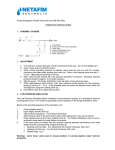
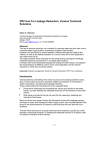
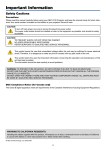
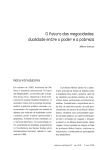
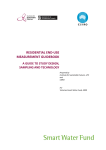
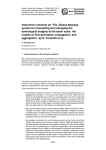


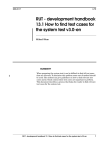
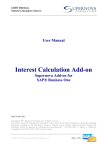
![[1 ] StorageTek SL8500](http://vs1.manualzilla.com/store/data/005684950_1-d7f31af8d49e38e9e4476c8a63e026d0-150x150.png)


